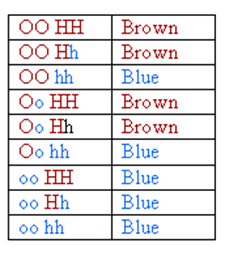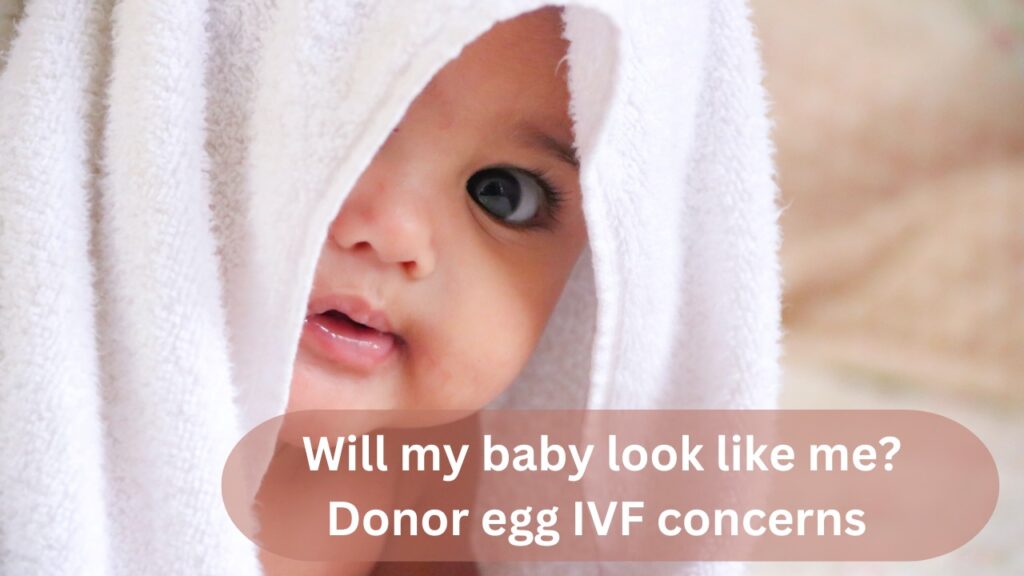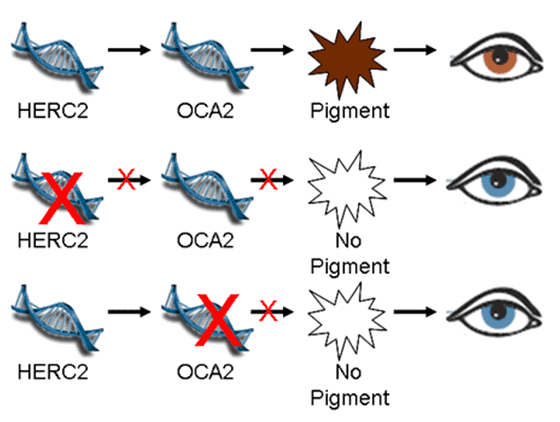Table of Contents
- 1 Genetic inheritance of appearance and donor eggs
- 2 Which traits are inherited from the egg (oocyte) donor?
- 3 Which traits are inherited from the egg recipient and her partner?
- 3.1 How does genetic inheritance affect the appearance of the baby? In other words: who will the baby look like?
- 3.2 Have you ever wondered how blue-eyed parents can produce a brown-eyed baby?
- 3.3 If you need help choosing an IVF Clinic Abroad, spare 3 minutes of your time. You will save at least a few hours.
If you are considering IVF with donor eggs, you may already have been on a long and complicated road to becoming a parent. You are not alone, as infertility affects millions of women, but sometimes the hurdles along the way seem insurmountable. We want to help by providing the information you need to decide if IVF with donor eggs is right for your family.
Women who are thinking about using donor eggs want to know if the baby will resemble them. The reality that your partner’s sperm will join another woman’s egg brings up all sorts of questions. You may be wondering:
- Will the baby look like me?
- Will the baby act like me?
- How can I bond with the baby?
- What will my children look like?
Genetics research is rapidly advancing, and many commonly held ideas about heredity have been proven false. In fact, heredity is much more complex than previously thought. With information from recent research studies, we can provide you with the most up-to-date material to assist in your decision.
There are many donor egg baby stories available online, where patients share their experiences not only regarding the process (IVF) but also regarding the baby look. It’s hard to find the stories where patients dont’t indetify themselves with a “baby look”.
We know that genes determine inheritance of appearance, but the specifics are complex. Physical traits are inherited for everything from eye and hair colour to blood type and Rh factor. In addition to these physical traits, there are other inherited characteristics, like personality, IQ and talents. All three people involved (egg donor, egg recipient and egg recipient’s partner) affect the growing fetus in different and significant ways, and the odds that a baby will look like any of them varies.
Get the facts on:
Donor eggs IVF cost
An egg recipient is not just an “incubator” for the baby. She is the mother and she provides everything the foetus needs to grow and develop. Licensed Clinical Social Worker Lissa Kline, who is Director of Member Services at Progyny, summed it up for an article in Psychology Today:
“The shape of the baby’s earlobe may have been genetically programmed by the donor’s great, great, grandfather, or the male partner’s (or even sperm donor’s) grandmother’s aunt, but the earlobe itself, and the rest of the baby, grew from the pregnant woman’s body. She may not be a genetic donor but carrying the child makes her the child’s biological mother”1
Licensed Clinical Social Worker – Lissa Kline
Here’s the short answer to the overriding question:
Yes, an egg recipient mother influences the development of an embryo created from a donor egg. How does this happen? Let’s explore.
Genetic inheritance of appearance and donor eggs
Each baby’s physical composition is determined by genetics. When couples use a donor egg, the genes of the egg donor and egg recipient’s partner combine and establish some undeniable traits. Common examples of traits that are passed through the generations are: ear lobe attachment, tongue rolling, freckles, dimples, handedness and red/green colour blindness. The egg recipient will have no effect on these characteristics, as they are hard wired in genetic code.
However, current scientific information suggests that genetic inheritance of appearance goes well beyond the simple, outdated notion that dominant and recessive genes can only produce finite variations. The combinations are literally endless.
How are traits passed down through the generations?
Each human has a unique genetic code. The building blocks of this code are known as deoxyribonucleic acid (DNA), and a long string of DNA is the blueprint for that particular person. For each human trait, there is a gene (or cluster of genes) that influences that trait. When egg cells and sperm cells combine, the individual DNA from each creates a new human with traits from both mother and father.
In order for traits to be passed from one generation to the next, the cells must go through a translation process. It is fairly complex, but the simplified explanation is this: a gene’s DNA sequence is converted to ribonucleic acid (RNA) which carries a message for the material to convert to proteins. This is known as gene expression. The way that the DNA is ultimately decoded and converted into protein determines how the gene expresses itself, or appears, in the baby.
You may also be interested in watching #IVFANSWERS episode: Epigenetics – do babies end up looking like the egg recipient?
When elements of genetic code combine, the genes follow some basic principles of inheritance, first identified by scientist Gregor Mendel in the 1800s:
- Law of Dominance
- Law of Segregation
- Law of Independent Assortment
These laws explain the basics of genetics that you probably learned in science class in high school: dominant genes suppress recessive genes. After years of research, we now know that it’s not that simple. There are all sorts of variations in gene expression, so we cannot definitively predict how a gene will express itself in offspring. This means that simply because mother and father both have blue eyes, we cannot state with certainty that the baby will also have blue eyes.
Punnett Square
The specifics of passing genetic characteristics from parent to child can best be described, visually, with a graph known as a Punnett Square. The diagram is used to predict the probability that a child will inherit a specific trait. Humans contain two copies of each specific gene. For each trait, one allele from the mother combines with one allele from the father, resulting in many possible variations of gene expression in the offspring. Where it gets tricky is that we now know that traits are usually determined by more than one gene, meaning that the original, simple Punnett Square is oversimplified and cannot tell the whole story.
Epigenetics
To further complicate the laws identified by Mendel, we look to the idea of epigenetics. The term’s literal meaning is: “in addition to changes in genetic sequence.” What this means on a practical level, is that heredity is determined by more than just DNA sequence. Epigenetics tells us that gene expression may also be influenced by matter other than its alleles. For couples considering IVF with donor eggs, epigenetics suggests that the baby may or may not look like a combination of the egg donor and the egg recipient’s partner; there are too many variations and unknowns to make that prediction. The baby may strongly resemble, moderately resemble, or share no resemblance to the egg donor, egg recipient or egg recipient’s partner.
Which traits are inherited from the egg (oocyte) donor?
The baby’s basic genetic code is inherited from the egg donor and the egg recipient’s partner. This means that everything from eye colour to adult height to blood type is determined their genes. However, this does not mean that the baby’s eye colour will be a combination of simple dominant/recessive elements of the egg donor and egg recipient.
Consider this example: the egg donor has blue eyes and the egg recipient’s partner has brown eyes. What colour eyes will the baby have? The outdated simplistic nature of dominant/recessive gene theory says the baby will have brown eyes. However, we know that there are actually numerous combinations for eye colour, because we cannot definitively predict how the genes will be expressed. The baby’s eyes could be brown, blue, green or even a combination of colours.
Please note that most of the clinics in Europe are obligated (according to national law) to match phenotype of the donor with the recipient. So in other words you as a patient – recipient can’t choose the egg donor by her appearance as the clinic will match it based on your look. For example, egg donation in Spain is well regulated by law and since the donation is fully anonymous the phenotype matching is required. Egg donation in Greece is regulated in a similar way – phenotype matching is required however additional donor’s information may be shared with the recipient.
If you’re considering undergoing an egg donation in Europe you may be interested in reading comprehensive guide to IVF with donor eggs in popular countries. We publish all releveant information about popular destinations regarding best IVF clinics in Europe, IVF law, costs, donor egg success rates and important limitations you need to be aware of before you go.
Want more insights?
Best IVF clinic in Czech Republic
Best IVF clinic in Greece
Best IVF clinic in North Cyprus
Which traits are inherited from the egg recipient and her partner?
The egg recipient’s partner is responsible for 50% of the baby’s genetic code, but what role does the egg recipient play in the baby’s appearance and development? While the baby does not directly receive DNA coding from the egg recipient, recent studies suggest that the recipient’s DNA does influence how the baby develops.
“The Fundacion Instituto Valenciano de Infertilidad, a non-profit research centre for reproductive health, and Stanford University have concluded that microRNA’s molecules secreted in the mother’s womb are capable of changing the genetic information of the developing foetus.” 2
Los Angeles-based neuroscientist Helder Filipe says scientists discovered that certain microRNAs were expressed in the uterine lining and appeared in the endometrial fluid. These micro RNAs affect gene expression, which means there is evidence that the baby can receive certain genetic inheritance from the egg recipient.
“The idea that the uterine environment can change gene expression in the embryo seems valid and not much of a surprise. This study just reveals a possible mechanism for that change – that’s worth being considered,” Filipe said. 2
In addition, the egg recipient affects how genes are expressed through her health and lifestyle choices. Nutrition is critically important to the creation of uterine lining and forming the placenta. For example, a fetus may be genetically predisposed to be extremely tall. However, if the egg recipient has poor nutrition and prenatal care, the “tall” genes may not receive the nourishment they need to fulfil the destiny of height.
How does genetic inheritance affect the appearance of the baby? In other words: who will the baby look like?
Some of the most common questions about inherited appearance concern these traits:
- Eye Color
- Hair Color and Hair Structure
- Skin and Complexion
- Weight
- Height
- Blood Type and RH Factor
Eye Color

The two genes linked to eye color are OCA2 and HERC2. They both have different versions (alleles), which represent brown color (O and H) and blue color (o and h). The reality is actually quite complex, but the simplified explanation is that between the mother’s and father’s genes there are 9 possible genetic combinations:
Have you ever wondered how blue-eyed parents can produce a brown-eyed baby?
The two different genes (OCA2 and HERC2 must work together to determine eye color. These genes need each other to function properly and produce the more common color, brown. When one or both of these genes are “broken,” little or no pigment is produced and the baby will have blue eyes. Because the genes must work together, it is possible for both blue-eyed parents to be carriers of the dominant brown color trait and produce a child with brown eyes. The illustration, below, describes the different outcomes when the two genes work together and when they do not. 4
Hair Colour and Hair Structure
Similar to eye color, the amount of melanin determines hair color. In addition to the amount of melanin present in the cells, the type of melanin is also a factor. Two types of melanin that create hair color are eumelanin and pheomelanin. Different amounts of each type of melanin produce different hair colors:
| Hair Color | Type and Amount of Melanin |
|---|---|
| Black | Large amount of eumelanin |
| Brown | Moderate amount of eumelanin |
| Blond | Very little eumelanin |
| Red | Mostly pheomelanin with a little eumelanin |
If you need help choosing an IVF Clinic Abroad, spare 3 minutes of your time. You will save at least a few hours.
If you are looking for an egg donation clinic abroad, use the EggDonationFriends unique patients tool – Clinic Matching Test. We analyse your needs and choose 3 overseas clinics which match your expectations. Our database of IVF centres includes only trusted fertility clinics which have experience in providing high quality services to international patients. The suggested IVF centres will contact you directly within 3 working days. Spare 3 minutes of your time – you will save at least a few hours! Our assistance is free of charge.
We are also happy to advise if you have already chosen IVF clinic abroad. The consultants from eggdonationfriends will be able to help you through any concerns you may have and maximise your chances of getting a positive outcome from your infertility treatment. It is understandable that you want the best IVF treatment in the world.






